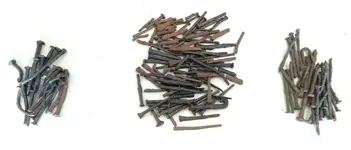Isaac
Hero Member
- Joined
- Oct 11, 2013
- Messages
- 773
- Reaction score
- 1,335
- Golden Thread
- 3
- Location
- Fairfax, Virginia
- 🥇 Banner finds
- 3
- Detector(s) used
- Whites MXT All Pro, Garrett AT Pro
- Primary Interest:
- Relic Hunting
Luke and I were tired of searching for a new spot and trying to get new permissions and wanted to revisit my go to "Halbach" site before it got dark. I decided to head to the area where I pulled my butt cap from, but I was already exhausted and didn't want to hear more machine gun iron, so I started randomly digging test holes. Sure enough, I found two pieces of the same pipe bowl, an early 1900s marble, and a small cuff flower button I missed before... Something sprouted in my head after that night.
The week after, I went back after school and did more amateur test holes and... they payed off! The batteries were completely dead in my detector so I had to get on my hands and knees and start looking for any irregular shapes or colors in the ground. Sure enough, the first thing I found was a lead button. I dug a few more buttons that day, including my first ever bone button. I get into a section that payed off big time. I first get a very nice half cent, an 1803. Less than 100,000 of these were made, so that was a little bonus. A few minutes later, I get a beautiful 1831 matron! I think the pit really helped care for these coins! At the very bottom of the pit, I found an almost complete iron spur! Couldn't believe it!
Two days later I did another after school hunt, I brought my detector this time and searched for large iron hits to hopefully find some interesting pieces. I ended up getting a padlock to start and then a colonial knife. I rescanned the hole where I got the knife and got a non-ferrous signal. It turned out to be a 1736-1760 1/4 Stuber from Cologne, Germany! I got another blasting iron signal nearby, opened up the plug, and there a beautiful reale layed only 3" deep! I couldn't even get the 3" signal. I wiped off the real with some water and it turned out to be in beautiful condition. Usually they are wiped. It was an 1807 half real. My first silver from this site! The iron turned out to be a padlock. I also got the Effigy Bear I posted last week! What an awesome evening!
Me and Brad have been planning to get out for months, but last weekend, our schedules finally coincided and we met at the site early on Saturday morning. It was such a pleasure being able to detect and sift with such an awesome guy! You couldn't ask for a better friend! He even let me have his sifter we used that day! We started out detecting for an hour. He used his XP Deus and I borrowed his T2. We only found a couple small flat buttons I missed with the MXT All Pro... despite it being a bulky machine, it got 99% of the 'surface' non-ferrous targets out. Once you learn it, you can pick almost all the targets from the iron. Brad says we should start digging a pit. The first hole we dug was very fruitful. Plenty of pipestems, pottery, and my first clay marble came out. The 2nd was awful, only one bone came out of the whole thing! The 3rd was insane though. I dig around and hear pottery scraping against my shovel. Half of an 1830s plate turns up on the edge of the hole! We continue digging down and scanning the hole and Brad gets a signal with his XP Deus. It turned out to be a beautiful 1811 half cent - a very rare coin!!! We dig a little more and get a few buttons each! I then say, let me get my trusty MXT in here and sure enough I get a blaring signal. Not too high, only a 40, but I see something grey and round. I thought tombac at first due to the low VDI, but was very happy to see it was holed, and a very dull Spanish half real! That's 2 half reals in 2 days from this site! This one is very very worn, but I came through with a date of 1781. After that, we start sifting the dirt that came out of that pit, plenty of pottery shards, glass, pipe stems, and a couple more clay marbles surfaced! When the sun came out from the trees at noon, we started losing energy very fast. I have to give props to Brad because he did a lot of work!!! On the last hole, on the last few shovel fulls, I spot something I've been looking for for a long time, a complete colonial pipe bowl! that was one of my most favorite days detecting and it was a huge pleasure to detect with such a class act! Hope everyone has a great summer!
that was one of my most favorite days detecting and it was a huge pleasure to detect with such a class act! Hope everyone has a great summer!
[]
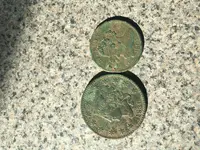
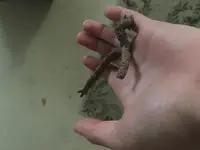
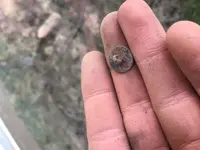
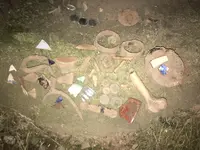
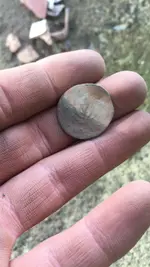
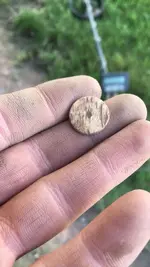
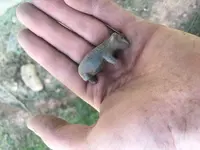
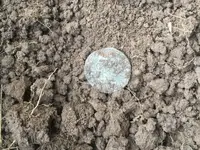
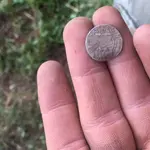
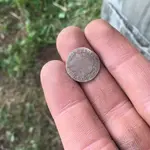
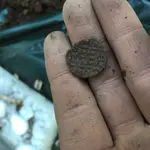
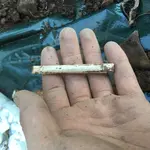
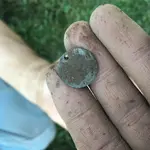
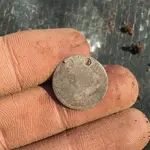
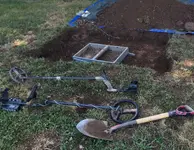
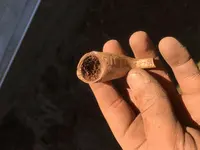
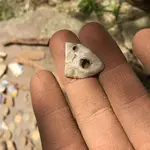
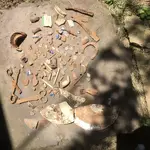
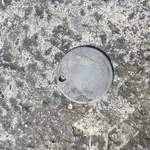
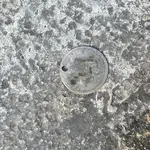
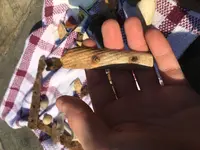
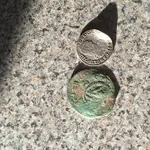
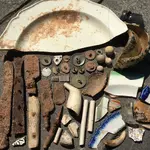
The week after, I went back after school and did more amateur test holes and... they payed off! The batteries were completely dead in my detector so I had to get on my hands and knees and start looking for any irregular shapes or colors in the ground. Sure enough, the first thing I found was a lead button. I dug a few more buttons that day, including my first ever bone button. I get into a section that payed off big time. I first get a very nice half cent, an 1803. Less than 100,000 of these were made, so that was a little bonus. A few minutes later, I get a beautiful 1831 matron! I think the pit really helped care for these coins! At the very bottom of the pit, I found an almost complete iron spur! Couldn't believe it!
Two days later I did another after school hunt, I brought my detector this time and searched for large iron hits to hopefully find some interesting pieces. I ended up getting a padlock to start and then a colonial knife. I rescanned the hole where I got the knife and got a non-ferrous signal. It turned out to be a 1736-1760 1/4 Stuber from Cologne, Germany! I got another blasting iron signal nearby, opened up the plug, and there a beautiful reale layed only 3" deep! I couldn't even get the 3" signal. I wiped off the real with some water and it turned out to be in beautiful condition. Usually they are wiped. It was an 1807 half real. My first silver from this site! The iron turned out to be a padlock. I also got the Effigy Bear I posted last week! What an awesome evening!
Me and Brad have been planning to get out for months, but last weekend, our schedules finally coincided and we met at the site early on Saturday morning. It was such a pleasure being able to detect and sift with such an awesome guy! You couldn't ask for a better friend! He even let me have his sifter we used that day! We started out detecting for an hour. He used his XP Deus and I borrowed his T2. We only found a couple small flat buttons I missed with the MXT All Pro... despite it being a bulky machine, it got 99% of the 'surface' non-ferrous targets out. Once you learn it, you can pick almost all the targets from the iron. Brad says we should start digging a pit. The first hole we dug was very fruitful. Plenty of pipestems, pottery, and my first clay marble came out. The 2nd was awful, only one bone came out of the whole thing! The 3rd was insane though. I dig around and hear pottery scraping against my shovel. Half of an 1830s plate turns up on the edge of the hole! We continue digging down and scanning the hole and Brad gets a signal with his XP Deus. It turned out to be a beautiful 1811 half cent - a very rare coin!!! We dig a little more and get a few buttons each! I then say, let me get my trusty MXT in here and sure enough I get a blaring signal. Not too high, only a 40, but I see something grey and round. I thought tombac at first due to the low VDI, but was very happy to see it was holed, and a very dull Spanish half real! That's 2 half reals in 2 days from this site! This one is very very worn, but I came through with a date of 1781. After that, we start sifting the dirt that came out of that pit, plenty of pottery shards, glass, pipe stems, and a couple more clay marbles surfaced! When the sun came out from the trees at noon, we started losing energy very fast. I have to give props to Brad because he did a lot of work!!! On the last hole, on the last few shovel fulls, I spot something I've been looking for for a long time, a complete colonial pipe bowl!
 that was one of my most favorite days detecting and it was a huge pleasure to detect with such a class act! Hope everyone has a great summer!
that was one of my most favorite days detecting and it was a huge pleasure to detect with such a class act! Hope everyone has a great summer! []























Upvote
21



 Seeing that 1781 Half Real made me smile for at least an hour... I have always thought I was cursed when it comes to silver... I rarely dig any and I rarely see anyone else dig any. So seeing that turn up made my day. Glad we got you a nice carved bone handle... you can soak it in Mineral Oil and it will condition the bone and bring out some colors in the bone. Definitely expand the pit in both directions and remember to empty it to the bottom until there is no more iron. I hope you find the rest of those two plates and can get one back together for a display. Do you have that rolled up pewter? I didn't see it in the pictures and if not, it might have been left behind. ha
Seeing that 1781 Half Real made me smile for at least an hour... I have always thought I was cursed when it comes to silver... I rarely dig any and I rarely see anyone else dig any. So seeing that turn up made my day. Glad we got you a nice carved bone handle... you can soak it in Mineral Oil and it will condition the bone and bring out some colors in the bone. Definitely expand the pit in both directions and remember to empty it to the bottom until there is no more iron. I hope you find the rest of those two plates and can get one back together for a display. Do you have that rolled up pewter? I didn't see it in the pictures and if not, it might have been left behind. ha
